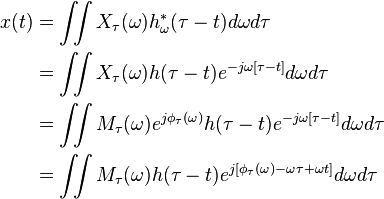The Method of Reassignment
Pioneering work on the method of reassignment was published by Kodera, Gendrin, and de Villedary under the name of Modified Moving Window Method Their technique enhances the resolution in time and frequency of the classical Moving Window Method (equivalent to the spectrogram) by assigning to each data point a new time-frequency coordinate that better-reflects the distribution of energy in the analyzed signal.
In the classical moving window method, a time-domain signal, is decomposed into a set of coefficients, based on a set of elementary signals, defined

where is a (real-valued) lowpass kernel function, like the window function in the short-time Fourier transform. The coefficients in this decomposition are defined

where is the magnitude, and the phase, of, the Fourier transform of the signal shifted in time by and windowed by .
can be reconstructed from the moving window coefficients by

For signals having magnitude spectra, whose time variation is slow relative to the phase variation, the maximum contribution to the reconstruction integral comes from the vicinity of the point satisfying the phase stationarity condition

or equivalently, around the point defined by

This phenomenon is known in such fields as optics as the principle of stationary phase, which states that for periodic or quasi-periodic signals, the variation of the Fourier phase spectrum not attributable to periodic oscillation is slow with respect to time in the vicinity of the frequency of oscillation, and in surrounding regions the variation is relatively rapid. Analogously, for impulsive signals, that are concentrated in time, the variation of the phase spectrum is slow with respect to frequency near the time of the impulse, and in surrounding regions the variation is relatively rapid.
In reconstruction, positive and negative contributions to the synthesized waveform cancel, due to destructive interference, in frequency regions of rapid phase variation. Only regions of slow phase variation (stationary phase) will contribute significantly to the reconstruction, and the maximum contribution (center of gravity) occurs at the point where the phase is changing most slowly with respect to time and frequency.
The time-frequency coordinates thus computed are equal to the local group delay, and local instantaneous frequency,  , and are computed from the phase of the short-time Fourier transform, which is normally ignored when constructing the spectrogram. These quantities are local in the sense that they are represent a windowed and filtered signal that is localized in time and frequency, and are not global properties of the signal under analysis.
, and are computed from the phase of the short-time Fourier transform, which is normally ignored when constructing the spectrogram. These quantities are local in the sense that they are represent a windowed and filtered signal that is localized in time and frequency, and are not global properties of the signal under analysis.
The modified moving window method, or method of reassignment, changes (reassigns) the point of attribution of to this point of maximum contribution  , rather than to the point at which it is computed. This point is sometimes called the center of gravity of the distribution, by way of analogy to a mass distribution. This analogy is a useful reminder that the attribution of spectral energy to the center of gravity of its distribution only makes sense when there is energy to attribute, so the method of reassignment has no meaning at points where the spectrogram is zero-valued.
, rather than to the point at which it is computed. This point is sometimes called the center of gravity of the distribution, by way of analogy to a mass distribution. This analogy is a useful reminder that the attribution of spectral energy to the center of gravity of its distribution only makes sense when there is energy to attribute, so the method of reassignment has no meaning at points where the spectrogram is zero-valued.
Read more about this topic: Reassignment Method
Famous quotes containing the word method:
“Unlike Descartes, we own and use our beliefs of the moment, even in the midst of philosophizing, until by what is vaguely called scientific method we change them here and there for the better. Within our own total evolving doctrine, we can judge truth as earnestly and absolutely as can be, subject to correction, but that goes without saying.”
—Willard Van Orman Quine (b. 1908)